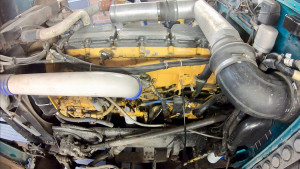 Be careful squeezing the nickel when it comes to preventative maintenance on the truck that makes your living possible and supplies your family with a car, food and a roof over their heads. What is the most important item in your life? If you are a trucker, keeping your wheels rolling is imperative to staying alive! It sounds dramatic, but it is true. Neglecting problems and ignoring preventative maintenance issues is one of the worst things you can do – so don’t do it!
Be careful squeezing the nickel when it comes to preventative maintenance on the truck that makes your living possible and supplies your family with a car, food and a roof over their heads. What is the most important item in your life? If you are a trucker, keeping your wheels rolling is imperative to staying alive! It sounds dramatic, but it is true. Neglecting problems and ignoring preventative maintenance issues is one of the worst things you can do – so don’t do it!
We recently removed a torsional damper from an ISX with 680,000 miles. The silicone “fluid” inside it had been hard for quite some time, negating the purpose of the damper, which is to help eliminate torsional vibrations. As I have said many times before, once this happens, stuff starts to crack and break – things like crankshafts, camshafts, alternator and compressor brackets, flywheel bolts, input shafts on the transmission, U-joints and carrier bearings.
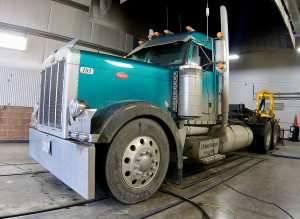 Think about this Kenworth with the destroyed torsional damper. We are replacing the damper, installing a mercury-filled engine balancer and the timing case cover. But what else is about to fail? This truck could turn out to be a mechanical disaster. It would be interesting to follow the failures of this truck for the next five years. How many times have you heard someone say their truck is a LEMON. Is it? Or were the problems created because of a faulty torsional damper that was neglected or ignored? If your engine isn’t running smooth, don’t ignore the symptoms – that will only manifest into greater problems.
Think about this Kenworth with the destroyed torsional damper. We are replacing the damper, installing a mercury-filled engine balancer and the timing case cover. But what else is about to fail? This truck could turn out to be a mechanical disaster. It would be interesting to follow the failures of this truck for the next five years. How many times have you heard someone say their truck is a LEMON. Is it? Or were the problems created because of a faulty torsional damper that was neglected or ignored? If your engine isn’t running smooth, don’t ignore the symptoms – that will only manifest into greater problems.
Our dyno is our best diagnostic tool when it comes to those hard-to-find issues. We recently had a customer visit us because his CAT 6NZ was bucking, sputtering, hesitating and generally running rough. When we ran it on the dyno, we found this was no stock 6NZ, but a fully-built motor with a performance cam and marine injectors. It put down 840 HP and 2,500 TQ on the first pull, all while running rough. Once we reviewed the data, the source of the problem became clear. Fuel pressure was dropping from about 90 psi to 30 psi from before the cylinder head to after the cylinder head. With a sight glass in 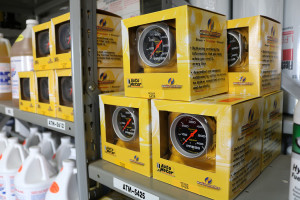 the fuel line, we verified there was air in the fuel.
the fuel line, we verified there was air in the fuel.
After more digging into this rough-running 6NZ, we found the primary air filter housing was cracked and letting air in the fuel. As for the lack of fuel pressure and/or volume, it had stock fuel lines and fuel pump and it seemed those marine injectors were demanding more than a standard 6NZ. The customer opted to make the repairs himself. For experimental purposes, we put a FASS system on the truck that increased fuel pressure and reduced air in the system. The result was 870 WHP and 2,600 WTQ, which means this 6NZ was making 1,000 flywheel HP (accounting for 15% drivetrain loss). We encourage owner operators to save money by learning to repair their own trucks, but if you get stuck with a problem you can’t figure out, bring it in.
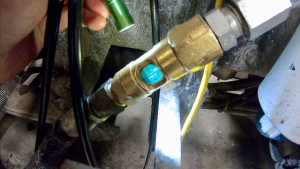 If you listen to our radio show with Kevin Rutherford (The Power Hour, on Tuesdays from noon to 2 pm EST), all the owner operators that call in and complain about poor fuel mileage do not have a turbo boost gauge or do not know what it means. My first question is always, “How much boost do you use when driving on the level and the wind is not blowing?” Many times, the answer is, “This is an old fleet truck and it didn’t come with a boost gauge.” My friends, the boost gauge kit is only $68.00, and it is easy to install – in fact, you can install it in your driveway or in the truck stop parking lot. If they have the boost gauge the answer is usually around 18 psi on the level. My trucking friends, there is NO fuel mileage at 18 or more psi of boost on the level.
If you listen to our radio show with Kevin Rutherford (The Power Hour, on Tuesdays from noon to 2 pm EST), all the owner operators that call in and complain about poor fuel mileage do not have a turbo boost gauge or do not know what it means. My first question is always, “How much boost do you use when driving on the level and the wind is not blowing?” Many times, the answer is, “This is an old fleet truck and it didn’t come with a boost gauge.” My friends, the boost gauge kit is only $68.00, and it is easy to install – in fact, you can install it in your driveway or in the truck stop parking lot. If they have the boost gauge the answer is usually around 18 psi on the level. My trucking friends, there is NO fuel mileage at 18 or more psi of boost on the level.
There could be many reasons why it is taking all that boost to move your rig at the speed you have chosen. First, try slowing down 5 mph and see if the boost drops 5 psi or more. Here is a list of other possibilities: the turbo could be too small and creating too much back pressure; the 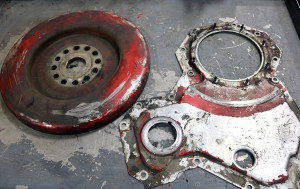 mufflers could be clogged or restrictive; the gap between the trailer and cab is too large (air can only jump 36 inches at highway speed); the trailer is loaded wrong; the exhaust manifold is undersized and will not allow the exhaust to escape from the engine; the truck is geared wrong; a bad ECM program; or you are NOT paying attention to the boost gauge and/or using cruise control on rolling terrain. I truly believe that driving is 66% of fuel mileage!
mufflers could be clogged or restrictive; the gap between the trailer and cab is too large (air can only jump 36 inches at highway speed); the trailer is loaded wrong; the exhaust manifold is undersized and will not allow the exhaust to escape from the engine; the truck is geared wrong; a bad ECM program; or you are NOT paying attention to the boost gauge and/or using cruise control on rolling terrain. I truly believe that driving is 66% of fuel mileage!
Recently I had an owner operator call who could not drive his DDEC5 under 18 psi of boost on the level. This trucker was from Minnesota and never gets East so I could not see the truck. After a few long conversations, I realized that someone had installed a 12.7 turbo on his 14-liter engine. I shipped him the performance turbo we use on a 14-liter Detroit, and with the same load and speed as before, his boost went from 18 psi to 8 psi. That was a gain of 1.25 mpg, less exhaust gas temperature and a more free-running truck.
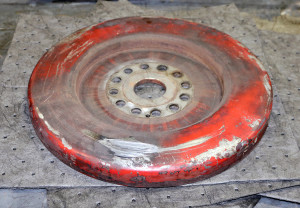 If your engine has EGR and a variable geometry (VG) turbo, the variable geometry section of the turbine housing may not be opening properly, soon enough or not enough. All three symptoms will lower your fuel mileage, cause the truck to drag and increase the exhaust gas temperature. Our engineering department can design an ECM program for your engine and your driving conditions.
If your engine has EGR and a variable geometry (VG) turbo, the variable geometry section of the turbine housing may not be opening properly, soon enough or not enough. All three symptoms will lower your fuel mileage, cause the truck to drag and increase the exhaust gas temperature. Our engineering department can design an ECM program for your engine and your driving conditions.
As you can see, many items determine fuel mileage, but it’s up to you to make the changes to your truck and your driving to optimize your mileage. Stop squeezing nickels and start driving a powerful and efficient rig! Got problems or questions? Call me or Andrew Wilson at Pittsburgh Power in Saxonburg, PA at (724) 360-4080.
